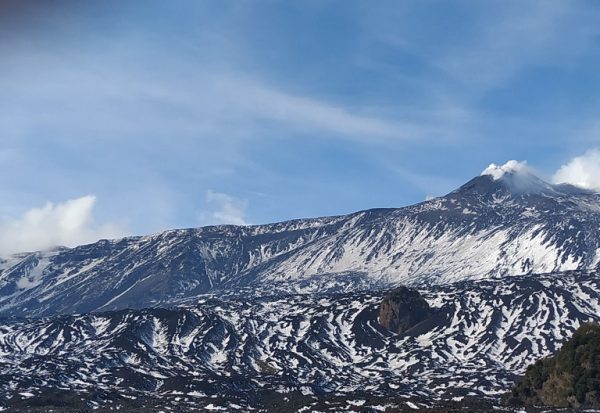If you live or visit the eastern flank of volcano Mount Etna, where the great valley Del Bove opens, you will certainly spot Rocca Musarra, the Musarra Rock. It rises from the volcano’s “belly” like a scary giant tooth, surrounded by century-old cold lavas. The Musarra rock is a silent witness of important history. In fact it tells us how did Etna appear thousands years ago. Not just a natural monument, this rock is also the place for adventurous hiking. And the living memory of tales about a very bad bandit guy!
Musarra Rock, the ancestor of Etna
 photo by Marco Neri
photo by Marco Neri
“The geological location of Rocca Musarra is problematic,” expert scholars say in their writings. Because it consists of stratified lavas so ancient that they are still trying to establish their origin. That is, if they belong to the southwest wall of the valley or to residual outcrops of the north wall. But everyone agrees that Rocca Musarra is what remains of the first volcanic apparatus, the so-called “Trifoglietto”, which collapsed over the millennia.
As the volcanologist doctor Marco Neri points out: “The rock emerges by erosion, due to the formation of the valley Del Bove, which ‘uncovered’ the eastern flank of the volcano through a huge landslide. It all presumably occurred around 10,000 years ago”. The Trifoglietto volcano had reached a maximum height of about 2400 m. Later, four minor eruptive centers were formed which overlapped completely on the flanks of the Rocche and Trifoglietto volcanoes. These volcanoes formed the stratovolcano-type structure of the current Etna building, a superposition of different eruptive centers. In short, looking at and touching the Musarra rock means reading the story of an ancestor of Etna, as one reads human history in a museum of archeology.
Admiring the rock of the bandit
Rocca Musarra is about 85 meters high, with an immersed base surrounded by layers and layers of lava flows. The rock rises from the new lava with its oldest rock walls, characterized by vertical stratifications and cracks. Wild vegetation grows luxuriantly at the top, a refuge for many species of birds. Every now and then the Etna goats also climb up there, though they usually prefer to live in the ravines of the other rocks nearby.
The name of the rock seems to derive from the legend of a famous bandit, whose surname was Musarra. He used to spread terror along the mule tracks on the eastern side of Etna. He would rob in particular the carters and merchants who went up or down between the mountain villages and the Ionian coast. After the raids, no one could ever find him because he just disappeared in the valley Del Bove. His refuge, in fact, was inside one of the cracks that open into the rock still named after him, today.
Excursion to the Musarra Rock
The hiking trail to reach Rocca Musarra starts from Rifugio Pietra Cannone, on the Mareneve Road
 photo by Marco Neri
photo by Marco Neri
in Milo. From there, walk along path 731 towards Rocca Capra among chestnut woods and lava flows. You will pass by the Case Fichera, old farmers’ houses half submerged by the lava of the 1979 eruption. Not far from there, a plaque commemorates the brave “Saro Ruspa” (Rosario Di Carlo). He was a caterpillar machine operator who, in 1992, helped to create a dam so to divert the eruption that threatened Zafferana.
The path that Saro Ruspa’s mechanical vehicle helped to trace, today is the way many hikers do follow. It facilitates the entry into the valley Del Bove. There you will walk on a real lava desert, skirting the so-called “Volcano of Rocche”, Rocca Capra and Rocca Palomba. Detached from the other high rocks, there is the Musarra rock. Thanks to the lava that has almost completely covered it on one side, you can even get to the top without too much effort. From up there you will admire the coast on one side and the current active craters of Etna on the other.
The whole route is quite heavy, due to often steep and difficult terrain. It takes a total of 4 hours walk, excluding stops, and covers almost 10 km on foot. We recommend it for those who are really well trained, or at least for those who are used to walking on paths that are not entirely linear. The difficulty is medium-high.
From where you can also admire Musarra
If you do not want to face the hard hike up to the foot of Rocca Musarra you can go to the panoramic points from which it is clearly visible. On the north side, from the road that goes up to Citelli, you can take the path to Monte Scorsone and Monte Rinatu. This leads to a viewpoint over the valley. The Musarra rock will be right at your feet.
Alternatively, following the shady and fascinating path of Monte Ilice, from Zafferana Etnea, you go up to the viewpoint of Monte Fontana. The Musarra rock will be one of the spectacular views that you can enjoy from this place. However, always make sure you walk these paths with expert guides. Because it is easy to get lost and even easier to fall, in some partsof the route, as it becomes narrow and slippery.
More important information
To go on excursion to Rocca Musarra or to the viewpoints, take the towns of Milo and Zafferana Etnea as points of reference. You can reach them easily from Catania and Taormina (A18 motorway, exit at Acireale or Giarre), then follow the road signs for Milo, Zafferana Etnea or Paesi Etnei.
The nearest airport is Fontanarossa di Catania.
There is no shortage of accommodation opportunities, especially in delightful family-run B & Bs. Both Milo and Zafferana towns are accustomed to tourism all year round.
(the photo above the title is by G Musumeci – for the photos inside the article special thanks to Dr. Marco Neri)